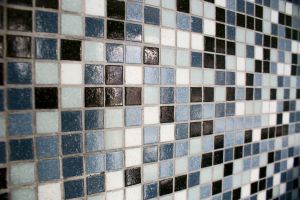Learn how to prepare walls and floors for tiles. Tiling can be daunting to the novice DIY-er. It can seem like a far more complex task than hanging wallpaper, for instance. With tiling, as with most DIY tasks, good preparation is the key to success.
Having a stable surface to work with, ensuring that you know how to plan and mark a field of wall tiles, and understanding how to cut and shape tiles correctly will all help to make your tiling project run smoothly. Before tackling any tiling, be sure to follow these simple rules.
Tiling Preparation Tips
1. Cleaning the Surface. Never be tempted to use tiles to cover old wall coverings such as wallpaper. It is essential that all traces of paper, flaking paint or plaster be removed before you start. An unsound surface is the biggest cause of tiling problems.
2. Skimming the Wall. Even a slightly uneven wall can spoil the finish of tiling. A thin layer of new plaster over the top of an uneven wall will result in a much more pleasing finish. This is especially important if using mirrored tiles.
3. Let Plaster Dry. If you are tiling over a newly plastered wall, make sure you let the plaster dry out thoroughly. Once it is dry, apply a primer sealer to stop the tile adhesive soaking into the porous plaster.
4. Tiling Over Tiles. It is possible to tile over existing tiles, but it is better to remove them if you can. If you have reason to believe the wall behind the existing tiles is flawed, and the tiles currently in place are sound and level, tiling over them might be the better option. Just remember that you will need to clean the tiles well and score the surface well with a blade. You can also rub the tiles down with silicon-carbide paper for even greater adhesion. Try not to line up the new grout lines with the old, as this may make the tiling weaker.
5. Painted Walls. If you are tiling over painted walls, wash them down well, rub them down with sandpaper and then remove all dust with a damp cloth.
6. Plan Your Tiling. Measure the area to be tiled carefully, work out how many tiles you will need to buy, and then add 10% more to allow for breakages. This is especially important if you are buying end of line tiles or tiles in the sales as they might be out of stock when you return a week/month/etc later to buy replacements.
 7. Planning Patterns. If you are planning on creating a pattern with different tiles, make sure you lay out the pattern on the floor to give you an idea how it will look before you start to affix tiles to the wall. If using patterned tiles, try not to place them at the edges of the wall or floor. If they need to be cut to fit, it will be a lot more noticeable with patterned tiles.
7. Planning Patterns. If you are planning on creating a pattern with different tiles, make sure you lay out the pattern on the floor to give you an idea how it will look before you start to affix tiles to the wall. If using patterned tiles, try not to place them at the edges of the wall or floor. If they need to be cut to fit, it will be a lot more noticeable with patterned tiles.
8. Be Organised. Have everything you need ready and close at hand before you start. Tile adhesive is designed to go off quickly, so stopping to look for a tool to scrape off the excess could mean it hardens before you have chance to remove it. And don’t forget the spacers! Trying to tile properly without tile spacers is just asking for trouble.
9. The Correct Adhesive. Choose the correct adhesive and the correct grout. Tile adhesive is available in a few different types, and not all of them will be suitable for all tiling jobs. If you are tiling the floor of your bathroom, you will need to ensure that the adhesive is waterproof (floor tile adhesive almost always is).
10. Concrete Floors. If you are tiling over a concrete floor, make sure that it is in good condition, completely clean and free from debris and as level as possible. It is sometimes better to line a concrete floor with hardboard and applying the tiles on top of that, than to try to make the best of a bumpy concrete surface.
11. Wooden Floors. When planning to tile over a wooden floor, ensure that the floorboards are all level and firmly nailed down. If your wooden floor is even slightly bumpy or uneven cover it with plywood or hardboard before tiling.
12. Plan for Breakages. Working out how many tiles you need to cover a wall is fairly simple. Just measure the height and width of the wall and work out how many full tiles fit into those measurement. If the tiles are 200 mm x 200 mm, and the wall is 2 m x 2 m, you will need 100 tiles to cover the wall. It is always worth buying around 10% more tiles than you actually need to cover the wall or floor, to allow for breakages or mistakes. This is particularly important if buying end-of-line tiles.
Following these tips might not make you a tiling expert, but they will make it easier for a novice to achieve a good result.







